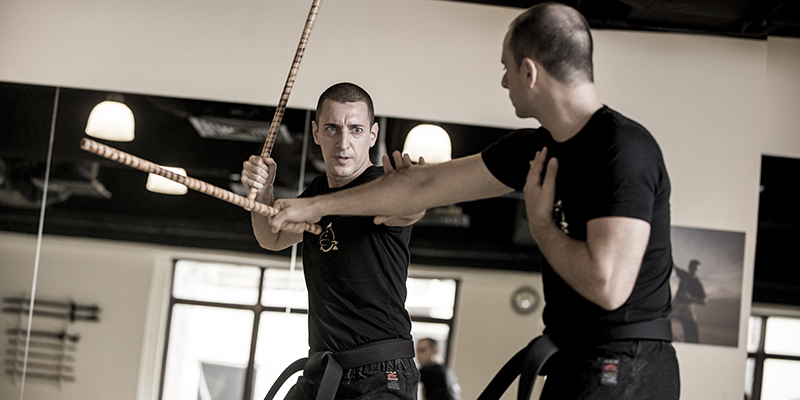
Filipino Martial Arts Terminology
• Abanico (Transl. Fanning): Striking, usually with a stick, that imitates a fanning motion (side to side)
• Alibata: Ancient script used primarily by Tagalog people. The term literally means “to spell, write and syllabize”. It is commonly used & associated to FMA Group Logo
• Arnis: (Transl. Harness) One of the common names for Filipino Martial Arts from the Northern part of the Philippines;
• Balisong: Foldable butterfly knife
• Bangkaw: (Staff or Bo) A piece of wooden rod or pole varying in lengths
• Barong: Leaf shaped blade weapon used by Filipinos in the Southern Philippines
• Baston: Stick or baton used in FMA
• Contra: Counter
• Corto: Short distance, Close range
• Crossada: “Crossing” stick disarm; maneuver used to block an incoming attack
by forming an ‘X’ pattern with one’s baton, arms or bladed weapon
• Daga: Knife or dagger
• Doble Baston: Double sticks fighting system
• Doble Doble: Training drill were specific hits are duplicated
• Dulo Dulo: Small palm size stick used as weapon. Spoken twice to indicate style
of fighting with said weapon
• Dumog: “Filipino grappling art” either in a clinch or on the ground. It is the
Wrestling system of FMA
• Dunga: (Transl. Point) Stabbing strike, usually with a blade; it is also called as
‘tusok’
• Earth/Heaven grip: Two basic grips on knife. If, when holding your arm straight
to the front, the point of the blade points upward that is “heaven grip”. If the knife is gripped so the blade exits the fist from a pinky side & points towards the floor, that is “earth grip”
• Elastico: Footwork used for largo mano stick sparring
• Eskrima: Fighting system of The Philippines. Other common terms are Arnis and
Kali.
• Espada y daga: Sword (espada) & dagger (daga) used together. Sometimes also
connotes the use of stick & knife tandem
• FMA: Common abbreviation for “Filipino Martial Arts”
• Gunting: Scissors or passing block which means wounding an opponents limb
through a slapping motion as one attempts to block an incoming strike
• Guro: (Transl. Teacher) Title used generally for instructors/teachers
• Hilot: Traditional healing system of the Philippines
• Hubud: “untie or undress” when coupled with lubud (blend); a term that connotes
a form of “flow” drill
• Kadena de Mano: (Transl. Chain of hands) The empty hands system at the core
of Filipino martial arts
• Kali: Fighting system of the Southern Philippines. Other common terms are Arnis
and Eskrima.
• Kampilan: Long sword found in The Philippines
• Karambit: (or Kerambit) Curved knife resembling a claw (single or double edged)
originally from the Malaysian/Indonesian archipelago.
• Kris/Keris: Wavy blade originally from the Malaysian/Indonesian archipelago, traditionally used as a stabbing weapon in Malaysia/Indonesia and a longer version sword in The Philippines
• Kuntaw (alt. Kuntao): “Fist way” a system of kung-fu adopted by Filipinos & shared in common with Indonesia
• Largo Mano: Long range extended movements, full extension of arms, legs & weapons, creating distance
• Largo: Long distance
• Lutang: Float
• Majapahit: Empire of today’s Southeast Asia in the 13th Century
• Medio: Medium distance
• Mirror mirror: Drill where the right meets the right & the left meets the left and
so on.
• Palusot (Transl. Passing through): Striking motion passing through something
(arms/legs) to go from the outside line of the opponent to the inside or vice-
versa.
• Panantukan: Boxing system from the Philippines, commonly known as “dirty
boxing” for its efficient self defense applications
• Passa: Passing defensive motion
• Pressure point: In Martial Arts are areas of the body where people can apply
pressure or strike in order to cause pain
• Punio: Butt or pommel of a weapon
• Redonda: Circular power striking motion, usually using stick
• Sarong: Piece of cloth used as clothes in Southeast Asia and also used as
weapon for fighting (ex: Sarong Silat)
• Serrada (getting close): close quarter combat executed at corto (close or short
distance) range. Also a style of escrima, popularized in the US by Angel Cabales • Sibat: Spear
• Sikaran: Kicking system from the Philippines; generally “striking with the leg”
• Silat: Fighting system found primarily in Malaysia, Indonesia, Singapore, Brunei
and the south of the Philippines.
• Sinawali: “To weave”, connoting the continous weaving motion that one uses
with two sticks, knives or hands to couple simultaneous strikes & blocks • Sipa: To kick
• Solo Baston: Single stick, usually made of rattan
• South Paw/Orthodox: Stance where the boxer has his right hand & right foot
foward is called “SouthPaw”; stance where the boxer has his left hand & left foot
forward is called “Orthodox”
• Suliwa: Pass or deflect
• Sumbrada: An upward, oblique “umbrella” block
• Tagalog: Language spoken in the Philippines
• Triangle footwork: the basic footwork of FMA; moving at 45 degree angles to
both evade or approach
• Tuloy Tuloy: (Transl. Flowing) Continuous striking movement, whether with or
without weapon.
Come & Experience It Yourself.

Get In Touch
How can we help to get you started?
